Topics
Category
Era
Betty Crocker Cake Mix
This Colorvision cake ad appeared in a 1952 edition of Family Circle magazine. Posted by Flickr user Classic Film, June 8, 2015. CC BY-NC 2.0.
General Mills did not invent cake mix, but in the early 1950s, Betty Crocker helped make it nationally popular as a staple of the American pantry.
In 1933, P. Duff and Sons, a Pittsburgh molasses company, patented the first cake mix after blending dehydrated molasses with dehydrated flour, sugar, eggs, and other ingredients. The mix required only water and baking to yield gingerbread.
By 1947, more than 200 companies produced cake mixes for regional distribution, but consumers were skeptical. Packaging was often inadequate and jeopardized the mix’s quality. Mixes remained expensive, produced inconsistent results, and lacked flavor. Some companies added soap to lighten the consistency.
After World War II, many women who had replaced soldiers in industrial jobs during the war resumed their domestic lives. American gender roles, however, had permanently shifted. In 1950, one in four married women was employed. With the return of domesticity and a newfound lack of time, women turned to products like Minute Rice and Reddi-Whip. Contrary to corporate predictions, women used convenience foods reluctantly, adopting them as ingredients in from-scratch recipes.
After four years of development, General Mills debuted its Betty Crocker Ginger Cake mix in 1947. General Mills joined the convenience-food movement because flour sales had been declining since the 1920s. Higher postwar incomes allowed families to buy bread instead of baking it. These higher incomes, coupled with increased nutritional awareness, drove households away from potatoes and breads toward diets of fruits, vegetables, and meats. General Mills hoped to compensate these flour losses with mix sales.
In 1949, General Mills debuted Devil’s Food and Party Cake mixes. Party Cake allowed consumers to prepare a white, yellow, or spice cake, depending on the eggs and spices added. Betty Crocker continually debuted new flavors: yellow cake and white cake in 1952, Honey Spice and Angel Food in 1953, marble in 1954, and chocolate in 1955.
Unlike other “convenience” foods, for many women cakes symbolized femininity and household happiness. Women felt pressured to perfect the homemade cake. A 1953 Gallup poll ranked cake the second “real test of a woman’s ability to cook,” behind apple pie. Domestic ideals split American women; - some accepted mixes while others clung to recipes.
Although cake mix sales tripled between January 1947 and August 1948, they soon plateaued. General Mills asked marketing expert Ernest Dichter to find out why. After interviewing groups of women, Dichter concluded that the simplicity of mixes made them feel too self-indulgent. So, General Mills removed dried eggs, requiring women to add their own. Sales improved.
In 1954, Betty Crocker debuted Answer Cake—cake and frosting mix pre-packaged in a pan—and marketed it to small families. Although later discontinued, Answer Cake returned as Stir ‘n Frost mix in 1976. Betty Crocker’s Chiffon cake mixes came out in 1958. Chiffon combined the richness of butter cake with the lightness of sponge cake and was created by celebrity caterer Harry Baker.
In affluent postwar America, products flooded grocery shelves, forcing companies to creatively sell their products to stay competitive. Betty Crocker, General Mills’s fictional homemaker mascot, embodied quality and value. General Mills used Crocker’s image to refute popular perception of mixes as “shortcuts.” Some Crocker devotees were shocked to see her marketing mixes.
General Mills drew female shoppers with “high impact” colors, such as their red packaging. It advertised with television commercials and even promoted a fourth meal consisting of Betty Crocker cake. Ads inundated women with reminders of their frantically busy schedules to sell “shortcuts” like mixes.
The company also steered attention away from the mix’s ease of preparation by promoting lavish frosting designs on packaging and in cookbooks. Appearance became the standard for success, trumping flavor and texture. The importance of appearance is exemplified in the success of Betty Crocker’s Picture Cookbook. Published in 1950, it sold over one million copies in its first year.
By the 1950s, General Mills, Duncan Hines, and Pillsbury monopolized the cake mix market. In 1977, General Mills, inspired by Pillsbury, added pudding to its mixes to make them more moist.
Since then, General Mills has marketed an array of cake mix formulas and flavors, including Stir’n Streusel and Light Style, a mix with one third fewer calories than the original. Betty Crocker cake mix remains popular in the 2010s.
Bibliography
Byrn, Anne. American Cake: From Colonial Gingerbread to Classic Layer, the Stories and Recipes Behind More Than 125 of Our Best-Loved Cakes. Emmaus, PA: Rodale, 2016.
“General Mills.” AdAge. September 15, 2003.
http://adage.com/article/adage-encyclopedia/general-mills/98669/
Gray, James. Business Without Boundary: The Story of General Mills. Minneapolis: University of Minnesota Press, 1954.
Kennedy, Gerald S. Minutes and Moments in the Life of General Mills. Minneapolis: Gerald S. Kennedy, 1971.
Liberman, Sherri. American Food by the Decades. Santa Barbara: ABC-CLIO, 2011.
Marks, Susan. Finding Betty Crocker: The Secret Life of America’s First Lady of Food. New York: Simon & Schuster, 2005.
Marling, Karal Ann. As Seen on TV: The Visual Culture of Everyday Life in the 1950s. Cambridge, MA: Harvard University Press, 1994.
Park, Michael. “A History of the Cake Mix, the Invention that Redefined ‘Baking.’” Bon Appetit. September 26, 2013.
https://www.bonappetit.com/entertaining-style/pop-culture/article/cake-mix-history
Shapiro, Laura. Something From the Oven: Reinventing Dinner in 1950s America. London: Penguin Books, 2005.
Related Resources
Secondary
Greenwood, Veronique. “Why Cake Mix Lacks One Essential Ingredient.” BBC Future, November 10, 2017.
http://www.bbc.com/future/story/20171027-the-magic-cakes-that-come-from-a-packet
Martyris, Nina. “Make America Bake Again: A History of Cake in the U.S.” National Public Radio, November 7, 2016.
https://www.npr.org/sections/thesalt/2016/11/07/501032393/make-america-bake-again-a-history-of-cake-in-the-u-s
“Retail Therapy: How Ernest Dichter, an Acolyte of Sigmund Freud, Revolutionized Marketing.” The Economist, December 17, 2011.
http://www.economist.com/node/21541706
Smith, Dinitia, “When Flour Power Invaded the Kitchen.” New York Times, April 14, 2004.
http://www.nytimes.com/2004/04/14/dining/when-flour-power-invaded-the-kitchen.html
Related Images
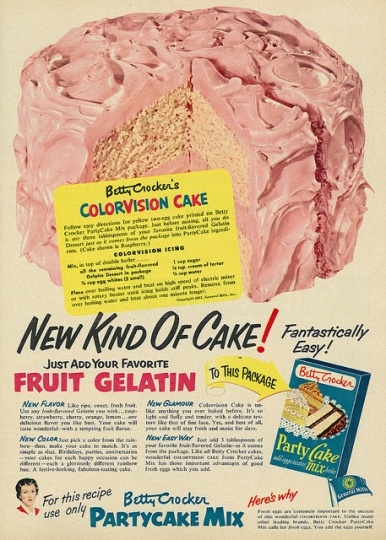
Colorvision Cake advertisement
This Colorvision cake ad appeared in a 1952 edition of Family Circle magazine. Posted by Flickr user Classic Film, June 8, 2015. CC BY-NC 2.0.
Holding Location
Articles
More Information
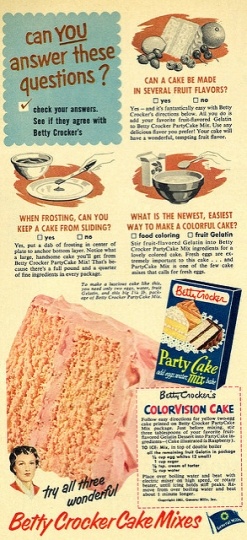
Advertisement for Colorvision cake
An ad for Colorvision cake includes a Betty Crocker baking quiz, suggestions, and bright graphics. Posted by Flickr user Classic Film, July 10, 2015.
Holding Location
Articles
More Information
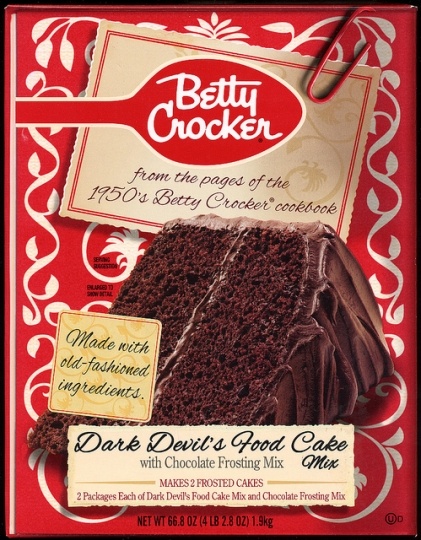
Dark Devil’s Food cake mix
Although from 2010, the box features a Betty Crocker logo and design.
Holding Location
Articles
More Information
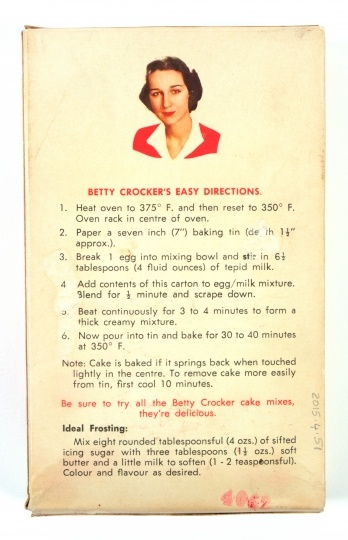
Cake Mix Baking Instructions
Betty Crocker’s instructions on how to mix and bake a cake.
Holding Location
Articles
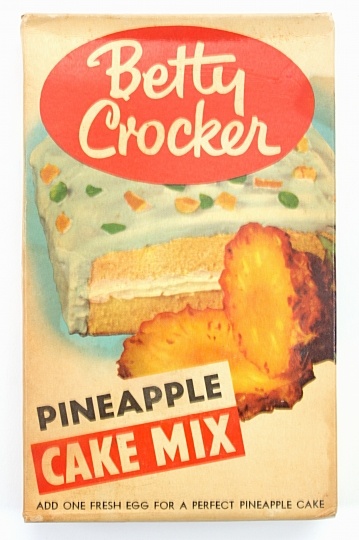
Pineapple Cake Mix
The front of Betty Crocker’s Pineapple Cake Mix. The box’s cake is decorated with light blue frosting and green and yellow candies. Collection of Tamaki Paenga Hira (Auckland War Memorial Museum), 2015.4.49. Gift of Mrs Yvonne Keesing.
Holding Location
Articles
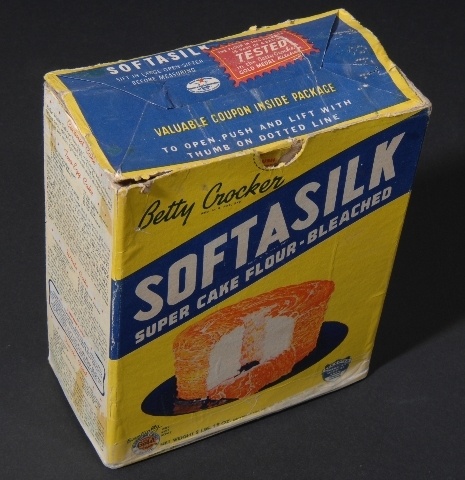
Softasilk Flour
Softasilk Cake Flour packaging, copyright ca. 1938. General Mills cake mixes used Softasilk Cake Flour. The flour addition caused their 1947 mix to be named “Ginger Cake,” not “Gingerbread.”
All rights reserved
Holding Location
Articles
More Information
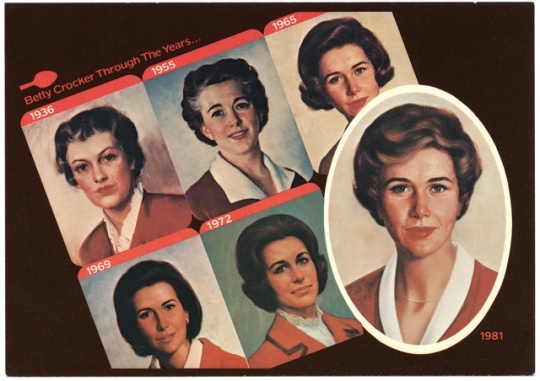
Betty Crocker
The portraits track Betty Crocker’s changing image through her years as the General Mills marketing icon.
Holding Location
Articles
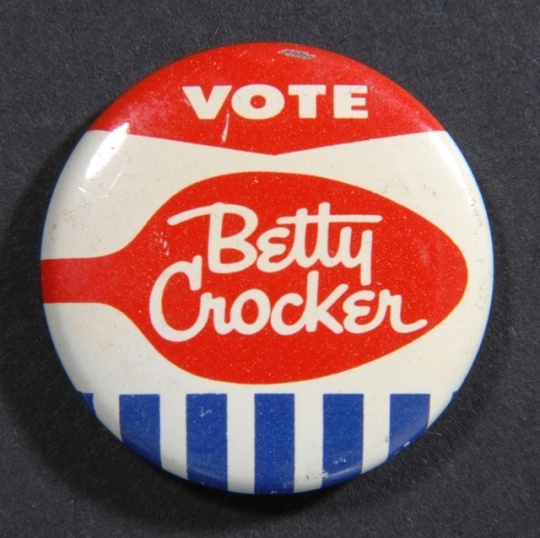
“Vote Betty Crocker” pin
“Vote Betty Crocker” pin, c.1950s.
All rights reserved
Holding Location
Articles
More Information
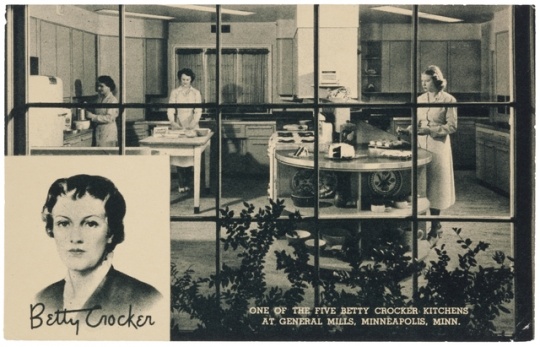
Betty Crocker Test Kitchens
Betty Crocker Test Kitchens, c.1950.
Holding Location
Articles
More Information
Related Articles
Turning Point
General Mills introduces cake mix in an attempt to compensate for falling flour sales and serve a new generation of working families reliant upon convenience foods.
Chronology
1933
1935
1947
1949
1950
1952
1953
1954
1977
1977
Bibliography
Byrn, Anne. American Cake: From Colonial Gingerbread to Classic Layer, the Stories and Recipes Behind More Than 125 of Our Best-Loved Cakes. Emmaus, PA: Rodale, 2016.
“General Mills.” AdAge. September 15, 2003.
http://adage.com/article/adage-encyclopedia/general-mills/98669/
Gray, James. Business Without Boundary: The Story of General Mills. Minneapolis: University of Minnesota Press, 1954.
Kennedy, Gerald S. Minutes and Moments in the Life of General Mills. Minneapolis: Gerald S. Kennedy, 1971.
Liberman, Sherri. American Food by the Decades. Santa Barbara: ABC-CLIO, 2011.
Marks, Susan. Finding Betty Crocker: The Secret Life of America’s First Lady of Food. New York: Simon & Schuster, 2005.
Marling, Karal Ann. As Seen on TV: The Visual Culture of Everyday Life in the 1950s. Cambridge, MA: Harvard University Press, 1994.
Park, Michael. “A History of the Cake Mix, the Invention that Redefined ‘Baking.’” Bon Appetit. September 26, 2013.
https://www.bonappetit.com/entertaining-style/pop-culture/article/cake-mix-history
Shapiro, Laura. Something From the Oven: Reinventing Dinner in 1950s America. London: Penguin Books, 2005.
Related Resources
Secondary
Greenwood, Veronique. “Why Cake Mix Lacks One Essential Ingredient.” BBC Future, November 10, 2017.
http://www.bbc.com/future/story/20171027-the-magic-cakes-that-come-from-a-packet
Martyris, Nina. “Make America Bake Again: A History of Cake in the U.S.” National Public Radio, November 7, 2016.
https://www.npr.org/sections/thesalt/2016/11/07/501032393/make-america-bake-again-a-history-of-cake-in-the-u-s
“Retail Therapy: How Ernest Dichter, an Acolyte of Sigmund Freud, Revolutionized Marketing.” The Economist, December 17, 2011.
http://www.economist.com/node/21541706
Smith, Dinitia, “When Flour Power Invaded the Kitchen.” New York Times, April 14, 2004.
http://www.nytimes.com/2004/04/14/dining/when-flour-power-invaded-the-kitchen.html










